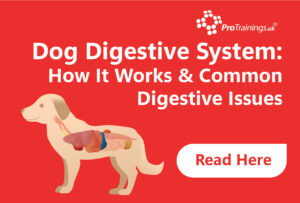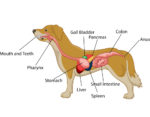How the Digestive Tract Processes Food and Nutrients
 The digestive system is central to your dog’s overall health, serving as the engine that converts food into usable energy and nutrients. It breaks down food into smaller components, absorbs these nutrients into the bloodstream, and eliminates waste products. This process begins when your dog takes a bite of food and continues through a series of coordinated steps involving several organs and systems.
The digestive system is central to your dog’s overall health, serving as the engine that converts food into usable energy and nutrients. It breaks down food into smaller components, absorbs these nutrients into the bloodstream, and eliminates waste products. This process begins when your dog takes a bite of food and continues through a series of coordinated steps involving several organs and systems.
• Ingestion and Initial Breakdown:
Digestion begins in the mouth, where food is chewed and mixed with saliva. Although dogs don’t rely as heavily on chewing as humans do, their teeth and jaw movements still help reduce food into smaller pieces, making it easier to swallow. Saliva contains enzymes that start breaking down certain carbohydrates, though much of the digestive action occurs later in the process.
• Swallowing and Stomach Digestion:
Once swallowed, food travels down the oesophagus, a muscular tube that propels the food into the stomach through rhythmic contractions called peristalsis. The stomach serves as a mixing chamber, churning food and combining it with gastric juices that contain hydrochloric acid and enzymes. These substances break down proteins and kill many potential pathogens. The stomach lining also produces mucus to protect itself from the acidic environment, ensuring that it can function effectively without harm.
 • Nutrient Absorption in the Intestines:
• Nutrient Absorption in the Intestines:
From the stomach, partially digested food, now called chyme, moves into the small intestine. This is where most nutrient absorption takes place. The small intestine is divided into three sections: the duodenum, jejunum, and ileum. As chyme enters the duodenum, it mixes with bile from the liver and enzymes from the pancreas. These substances help emulsify fats and further break down proteins and carbohydrates.
In the jejunum and ileum, the digested food particles are absorbed through the intestinal walls into the bloodstream. The small intestine’s lining is covered in tiny finger-like projections called villi, which increase the surface area available for absorption. This highly efficient system ensures that nutrients, including amino acids, fatty acids, vitamins, and minerals, are extracted and delivered to the rest of the body.
• Water Absorption and Waste Elimination:
Once the nutrients are absorbed, the remaining undigested material moves into the large intestine or colon. Here, water and electrolytes are reabsorbed, helping to maintain hydration and electrolyte balance. The large intestine also hosts a community of beneficial bacteria that further break down certain fibres and produce essential nutrients. Finally, the remaining waste products are compacted into faeces and stored in the rectum until they are eliminated through defecation.
Key Organs: Stomach, Intestines, Liver, Pancreas
The digestive tract relies on several organs that work together to ensure food is adequately processed and nutrients are efficiently absorbed:
• Stomach:
The stomach is a muscular sac that churns food and mixes it with gastric juices. It has a dual role: breaking down proteins and serving as a temporary storage area, releasing food gradually into the small intestine for thorough digestion. Its acidic environment not only aids in digestion but also helps protect against harmful bacteria that may be present in food.
• Small Intestine:
As the main site of nutrient absorption, the small intestine is critical in ensuring a dog gets the energy and building blocks it needs from food. The villi and microvilli lining the intestine provide an enormous surface area for efficient absorption. In contrast, the pancreas and liver provide the necessary enzymes and bile to break down complex molecules.
• Large Intestine (Colon):
The large intestine is shorter but more expansive than the small intestine. Its primary job is to reclaim water and electrolytes, compact the remaining material, and host a diverse microbiome. This community of bacteria not only aids in digestion but also supports immune health and produces certain vitamins, like vitamin K.
• Liver:
The liver is a powerhouse organ that produces bile, a substance essential for the digestion and absorption of fats. It also processes nutrients absorbed from the intestines, converting them into forms the body can use. Beyond digestion, the liver stores certain vitamins and minerals helps detoxify harmful substances and produces proteins important for blood clotting and overall metabolic health.
• Pancreas:
The pancreas plays a dual role, producing enzymes that digest proteins, carbohydrates, fats, and hormones that regulate blood sugar. When food enters the small intestine, the pancreas releases digestive enzymes into the duodenum, ensuring that nutrients can be broken down into absorbable forms. The proper function of the pancreas is critical for maintaining overall digestive efficiency and preventing nutrient deficiencies.
Common Digestive Issues and How to Prevent Them
While the digestive system is remarkably resilient, it can sometimes encounter problems. Many digestive issues in dogs stem from diet, stress, infections, or underlying medical conditions. Understanding and how to prevent these problems can help ensure your dog’s digestive health remains in top shape.
• Gastroenteritis (Stomach Upset):
One of the most common digestive complaints, gastroenteritis, can be caused by dietary indiscretion (eating something they shouldn’t), stress, or infections. Symptoms often include vomiting, diarrhoea, and lethargy. Preventing gastroenteritis involves providing a consistent, balanced diet, keeping harmful foods and toxic substances out of reach, and gradually introducing any dietary changes.
• Food Intolerances and Allergies:
Some dogs may have difficulty digesting certain ingredients, resulting in chronic diarrhoea, flatulence, or itchy skin. Identifying the offending ingredient, often through an elimination diet and switching to a hypoallergenic or limited-ingredient diet, can alleviate symptoms. Feeding a consistent, high-quality diet from a young age can also help prevent the development of sensitivities.
• Pancreatitis:
Pancreatitis, or pancreas inflammation, often occurs when a dog consumes fatty or rich foods. This condition can cause severe abdominal pain, vomiting, diarrhoea, and appetite loss. Prevention involves avoiding high-fat treats, maintaining a healthy weight, and feeding a low-fat, well-balanced diet.
• Bloat (Gastric Dilatation-Volvulus):
Bloat is a life-threatening condition where the stomach fills with gas and may twist. It’s most common in large, deep-chested breeds. While the exact cause isn’t fully understood, rapid eating, overeating, and vigorous activity after meals are thought to contribute. Preventive measures include feeding smaller, more frequent meals, using slow-feeder bowls, and ensuring your dog has time to rest before and after eating.
• Parasites and Infections:
Intestinal parasites like roundworms, hookworms, and giardia can cause diarrhoea, weight loss, and malnutrition. Preventing these issues involves regular deworming, cleaning your dog’s environment, and practising good hygiene. Routine veterinary check-ups and faecal testing can help detect and treat parasites early.
• Dietary Imbalances:
Feeding an unbalanced diet, such as one lacking in essential nutrients, can lead to poor digestion, nutrient deficiencies, and even digestive disorders. Ensuring your dog’s diet is appropriate for their age, breed, and activity level and choosing high-quality commercial foods or carefully balanced homemade recipes can prevent these problems.
By understanding how the digestive system works, the role of key organs and the common issues that can arise, you can take proactive steps to maintain your dog’s digestive health. A healthy digestive system supports a happy, energetic pet and lays the foundation for a long, fulfilling life.

